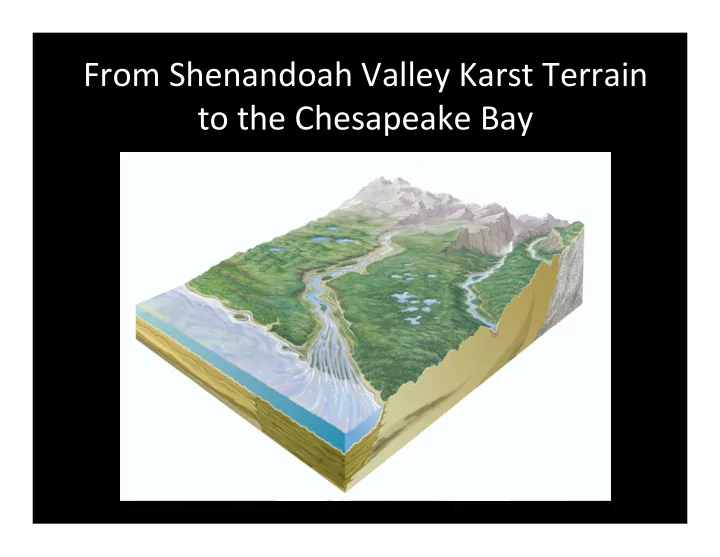

From Shenandoah Valley Karst Terrain to the Chesapeake Bay
Let’s Start at the Beginning
The Water Budget Precipitation Evapotranspiration Surface Runof f Groundwater
Ground Water Criteria for Flowing Water Porosity – voids in bedrock to hold water Permeability – ability of water to flow through the rocks Fractures Other open spaces
Fracture Flow
Watersheds of VA
Geology of the Shenandoah Valley To the East on the Blue Ridge 500 million to 1.1 billion year old sediments – Igneous rocks including volcanic rocks; sedimentary rocks including silts, sands, and shale. To the West 320 – 410 millions year old shale and sandstone Most of central Shenandoah Valley 410 to 500 million year old Primarily limestone and dolomite
Limestone/Dolomite Terrain of the Shenandoah Valley Source: Environmental Science Institute, University of Texas at Austin
Karst – How would you define it? Karst is Landscape or Topography Term Karst is a landscape shaped by the dissolution of a layer or layers of soluble bedrock, usually carbonate rock such as limestone or dolomite .
Counties in VA Containing Karst Source: Virginia Department of Conservation & Recreation,
Department of Conservation and Recreation, Virginia Karst Program
How is Karst Formed
Source: Environmental Science Institute, University of Texas at Austin
Clarke County, VA
C A V E S
Department of Conservation and Recreation, Virginia Karst Program
Water Budget for the Limestone Terrain Evapotranspiration – 50 ‐ 80% Surface Runoff – Less than 10% Water Table Recharge 30 ‐ 40%
What do we know? Map of the watershed and its link to the Chesapeake General geology of the Valley and specifically the limestone and dolomite terrain Water budget for limestone and dolomite terrain Characteristics of karst topography
If less than 10% of the precipitation is surface runoff , what feeds the streams and rivers? In the carbonate areas of the Valley up to 95% is coming from the groundwater, AND, this percentage may increase during times of drought.
What are the facts? From looking at the Karst Model? Precipitation moves quickly and abundantly into the groundwater. That means that most of what is on the ground, will end up in the groundwater with minimal filtering by the soils. From the Research The majority of stream/river water comes from the groundwater – up to 95% or more. Some moves quickly into streams and rivers (2 – 3 days), some moves slowly (100 – 1,000 yrs). Water in these sediments is high in Oxygen
Why Do We Care What Happens in the Shenandoah Valley?
Why Do We Care What Happens in the Shenandoah Valley? All land ‐ use practices that add chemicals to the ground can be quickly transported to the groundwater. The groundwater is transporting those chemicals to the streams and rivers in 2 days to 100s of years. Once in the groundwater, there is no capacity in the limestone and dolomite to denitrify nitrates, one of the big problems for the Chesapeake. Any nitrates on the land will flow into the groundwater and become part of the base flow for the streams and rivers that feed the Chesapeake.
What is it about nitrates that pose a problem? aa Why can’t the limestone and dolomite sequences denitrify the nitrates?
Fixing the Problem What can we do? Consider all farming and land ‐ use practices. Manage what you put on the ground. When fertilizing, put on what you need when the plants can absorb it. Use best management practices for waste ‐ water. Don’t assume that whatever you try will fix the problem immediately. Some water takes 100 or more years to move out of the groundwater.
2012 • Chesapeake Bay ‘dead zone' smaller this year (Baltimore Sun, June 22, 2012) • DNR says warmer, drier conditions this winter, compared to the extremely wet spring last year may be the difference. (CBS – Baltimore, June 21, 2012)
Recommend
More recommend